HOOKUP
1: a state of cooperation or alliance
2: an assembly or connection of components into a circuit, machine, or system
3: a device for conveying substances or information from a source to a user
2: an assembly or connection of components into a circuit, machine, or system
3: a device for conveying substances or information from a source to a user
COACH - PROFESSORSHIP AT THE ACADEMY OF FINE ARTS, VIENNA
Design Studio IKA Academy of fine Arts, Vienna
Bachelors Winter Semester 2021 / 22 - Michelle Howard and Eva Sommeregger
Design Studio IKA Academy of fine Arts, Vienna
Bachelors Winter Semester 2021 / 22 - Michelle Howard and Eva Sommeregger
What direction would technology have taken if the skills that are normally attributed to women and other anomalies were given the attention they deserve?
Starting from the premise that the first tool was not the weapon, but the carrier bag, we built sociable collectives constructing lines together, upcycling discarded materials, mainly t-shirts, following the path of the line through the medium of yarn.
With the words of Paul Klee in mind, who insisted that the processes of genesis and growth that give rise to forms in the world are more important than the forms themselves. ‚Form is the end, death, Form-giving is life‘. emphasis was placed on process. We looked closely at the complex workings of coordination between the yarn, the tool, the hands and the brain by hooking up to a bespoke device that we assembled together.
We began with mathematics and the hyperbolic surface, which is difficult to represent using norm.technology. In 1997, the Latvian mathematician, Daina Taimina discovered that they could be represented using the ignored.technology of crochet. Machines are unable to replace the dextrous hand in crochet which resists, as Tim Ingold puts it „how the line, has been gradually shorn of the movement that gave rise to it. Once the trace of a conscious gesture, the line has been fragmented - under the sway of modernity - into a succession of points or dots „
Walking, weaving, observing, storytelling, singing, drawing and writing all proceed along lines. Lines can be interrupted but also have the potential to reconnect, interweave and eventually become endless.
Starting from the premise that the first tool was not the weapon, but the carrier bag, we built sociable collectives constructing lines together, upcycling discarded materials, mainly t-shirts, following the path of the line through the medium of yarn.
With the words of Paul Klee in mind, who insisted that the processes of genesis and growth that give rise to forms in the world are more important than the forms themselves. ‚Form is the end, death, Form-giving is life‘. emphasis was placed on process. We looked closely at the complex workings of coordination between the yarn, the tool, the hands and the brain by hooking up to a bespoke device that we assembled together.
We began with mathematics and the hyperbolic surface, which is difficult to represent using norm.technology. In 1997, the Latvian mathematician, Daina Taimina discovered that they could be represented using the ignored.technology of crochet. Machines are unable to replace the dextrous hand in crochet which resists, as Tim Ingold puts it „how the line, has been gradually shorn of the movement that gave rise to it. Once the trace of a conscious gesture, the line has been fragmented - under the sway of modernity - into a succession of points or dots „
Walking, weaving, observing, storytelling, singing, drawing and writing all proceed along lines. Lines can be interrupted but also have the potential to reconnect, interweave and eventually become endless.
Instructors:
Michelle Howard and Eva Sommeregger
Students:
Sofia Abendstein, Arda Arin, Leonard Vincent Behrens, Vladislava Bugaeva, Elliott Griffith, Luke Handon, Paula Hauschildt, Lucia Herber, Justa Jasaityte, Juliane Jungblut, Marie Lang, Ji Yun Lee, Soryun Lee, Majed Naseri, Emma Malea Noll, Laurin Saied, Florentin Schumann, Moritz Tischendorf, Xaver Wizany
Thanks to:
Adam Hudec, Veronika Miskovicova, Jan Kristek, Saša Smolej, Ana Paula Ramirez Venegas, Hsing Jen Lee, Klarissa Ach-Hübner, Diana Bevelaquova, Tarek Malaheifi, Carmen Lael Hines, Ebru Kurbak, Monica Titton,
Michelle Howard and Eva Sommeregger
Students:
Sofia Abendstein, Arda Arin, Leonard Vincent Behrens, Vladislava Bugaeva, Elliott Griffith, Luke Handon, Paula Hauschildt, Lucia Herber, Justa Jasaityte, Juliane Jungblut, Marie Lang, Ji Yun Lee, Soryun Lee, Majed Naseri, Emma Malea Noll, Laurin Saied, Florentin Schumann, Moritz Tischendorf, Xaver Wizany
Thanks to:
Adam Hudec, Veronika Miskovicova, Jan Kristek, Saša Smolej, Ana Paula Ramirez Venegas, Hsing Jen Lee, Klarissa Ach-Hübner, Diana Bevelaquova, Tarek Malaheifi, Carmen Lael Hines, Ebru Kurbak, Monica Titton,
Kumst Brno, Caritas Vienna, Volkshilfe Vienna,
Funding: AKTION OEAD, Academy of Fine Arts Vienna
Funding: AKTION OEAD, Academy of Fine Arts Vienna
IGNORED TECHNOLOGIES
An exhibition which asks what direction technology would have taken if the skills that are normally attributed to women given the attention they deserve.
www.ignored.technology
Starting from the premise that the first tool was not the weapon, but the carrier bag, we built sociable collectives constructing lines together, upcycling at opposite ends of the fabrication process. Two separate but intertwined architecture studios, “Treads and Traces” at the Fa Vut in Brno and “HOOKUP” at the Academy of fine arts in Vienna, followed the path of the line through the medium of yarn.
In Brno, we use raw untreated wool from Slovakian Laucane sheep, now so undervalued (because of the perceived superiority of the Australian Merino), that the famer preferred to donate it to us. In Vienna we use discarded T-shirts. We followed Paul Klee who insisted that the processes of genesis and growth that give rise to forms in the world are more important than the forms themselves. ‘Form is the end, death, Form-giving is life’.
In Brno, the emphasis lies in the process of the creation of yarn and the manufacture of string. In Vienna, form is given using crochet and the mathematical equation. In 1997, the Latvian mathematician, Daina Taimina discovered that the hyperbolic surface could be represented using the technology of crochet which still remains the domain of the dextrous hand. Machines are unable to replace crochet which resists “how the line, in the course of its history, has been gradually shorn of the movement that gave rise to it. Once the trace of a continuous gesture, the line has been fragmented – under the sway of modernity – into a succession of points or dots……...”[1]
Performance and filmic observation HOOKUP the works in this exhibition to one another, celebrating the form-giving process. The pieces presented in the exhibition are deliberately open, in the words of Umberto Eco when he talked of the Open Work of Art, they are COMPLETED, NOT CLOSED.
LOCATION OF EXHIBITION
In the main Exhibition Space of the KUMST in Brno, Czech Republic
EXHIBITION DATES
08 January – 04 March 2022
BRNO Teachers: Michelle Howard, Adam Hudec and Veronika Miskovicova
BRNO Students: Bevelaquová Diana, Ach-Hübner (Kyselková) Klarisa, Smolej Sasa, Ana Paula Ramírez Venegas
VIENNA Teachers: Michelle Howard and Eva Sommeregger
VIENNA Students: Abendstein Sofia, Arin Arda, Behrens Leonard Vincent, Bugaeva Vladislava, Griffith Elliott, Handon Luke, Hauschildt Paula, Herber Lucia, Jasaityte Justa, Jungblut Juliane, Lang Marie, Lee Ji Yun, Lee Soryun, Naseri Majed, Saied Laurin, Schumann Florentin, Tischendorf Moritz, Wizany Xaver
EXHIBITION PARTNERS
Centrum Traditional Technologies Pribor https://www.muzeumnj.cz/pribor
FAVUT https://www.fa.vutbr.cz/
Technical Museum of Brno https://www.tmbrno.cz/
KUMST Brno https://www.kumstbrno.cz/
BILUM
In Tok Pisin, a language of Papua New Guinea, bilum means womb. But it also refers to a string bag made by hand using yarn from twisted plant fibres and technology known as looping, knotless netting, or crocheting. Traditionally slung behind from the head, it is capable of carrying both light and heavy loads, including small children.
[1] From Lines: A Brief history by Tim Ingold, ISBN 9781138640399, Published April 11, 2016, by Routledge




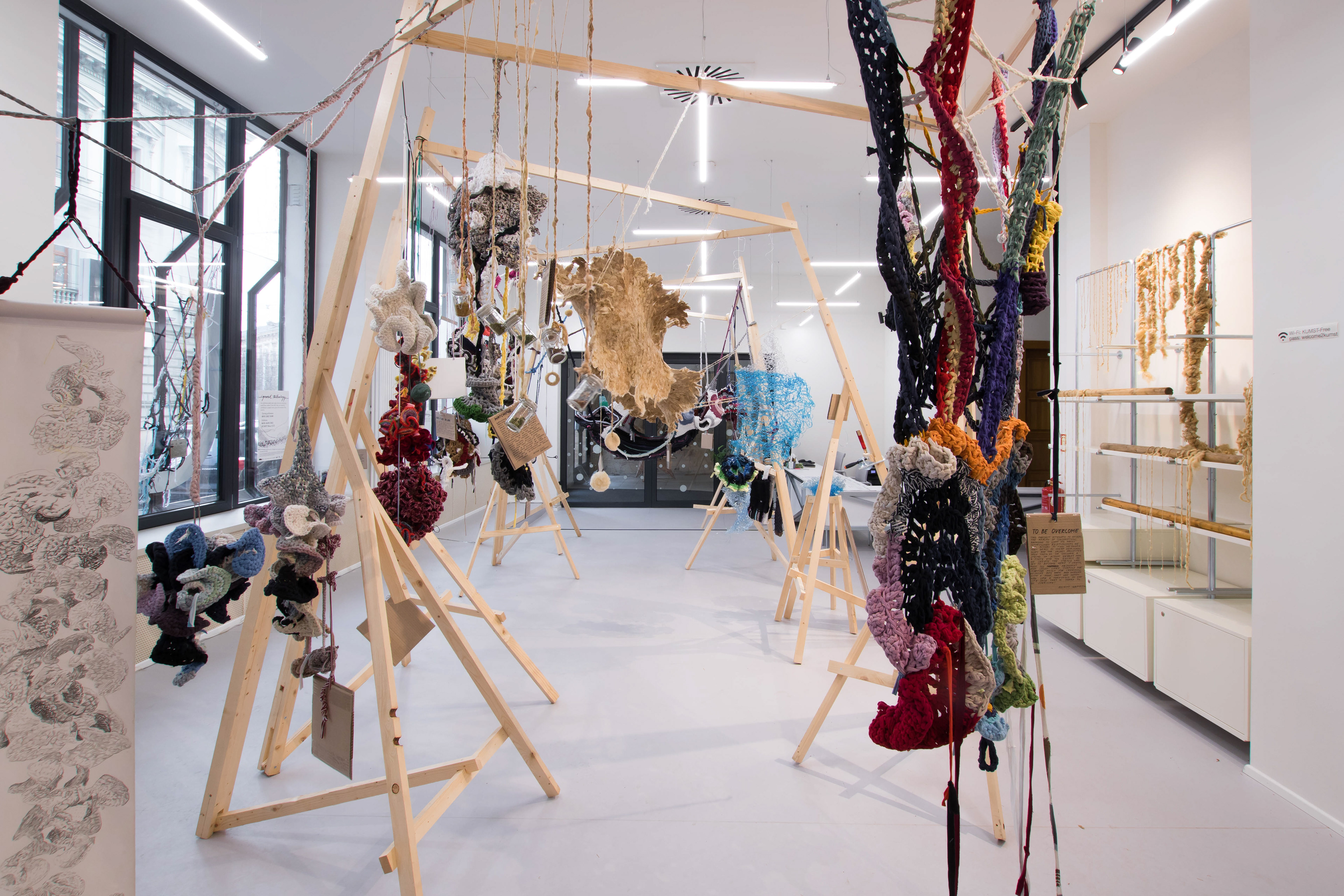
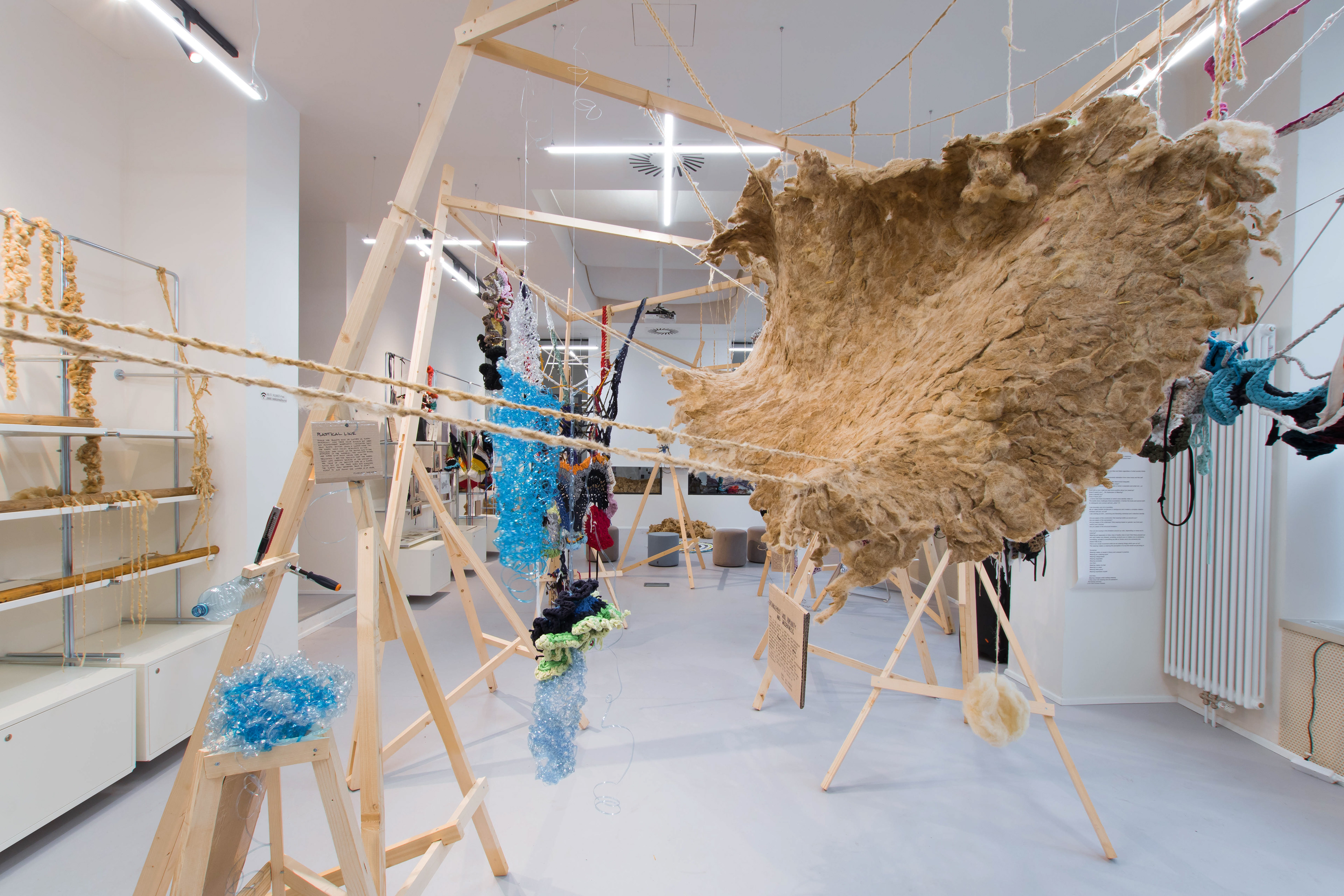

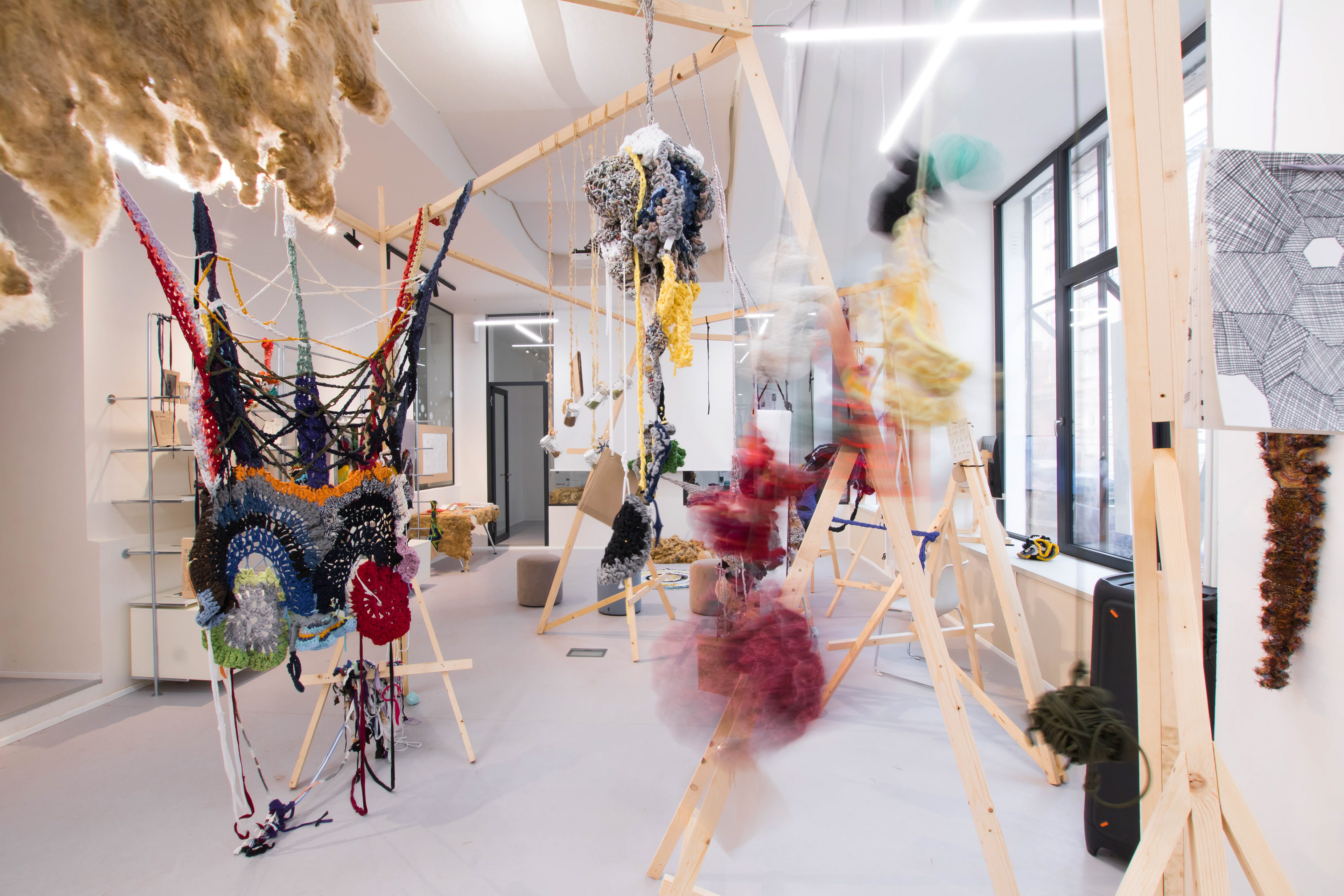
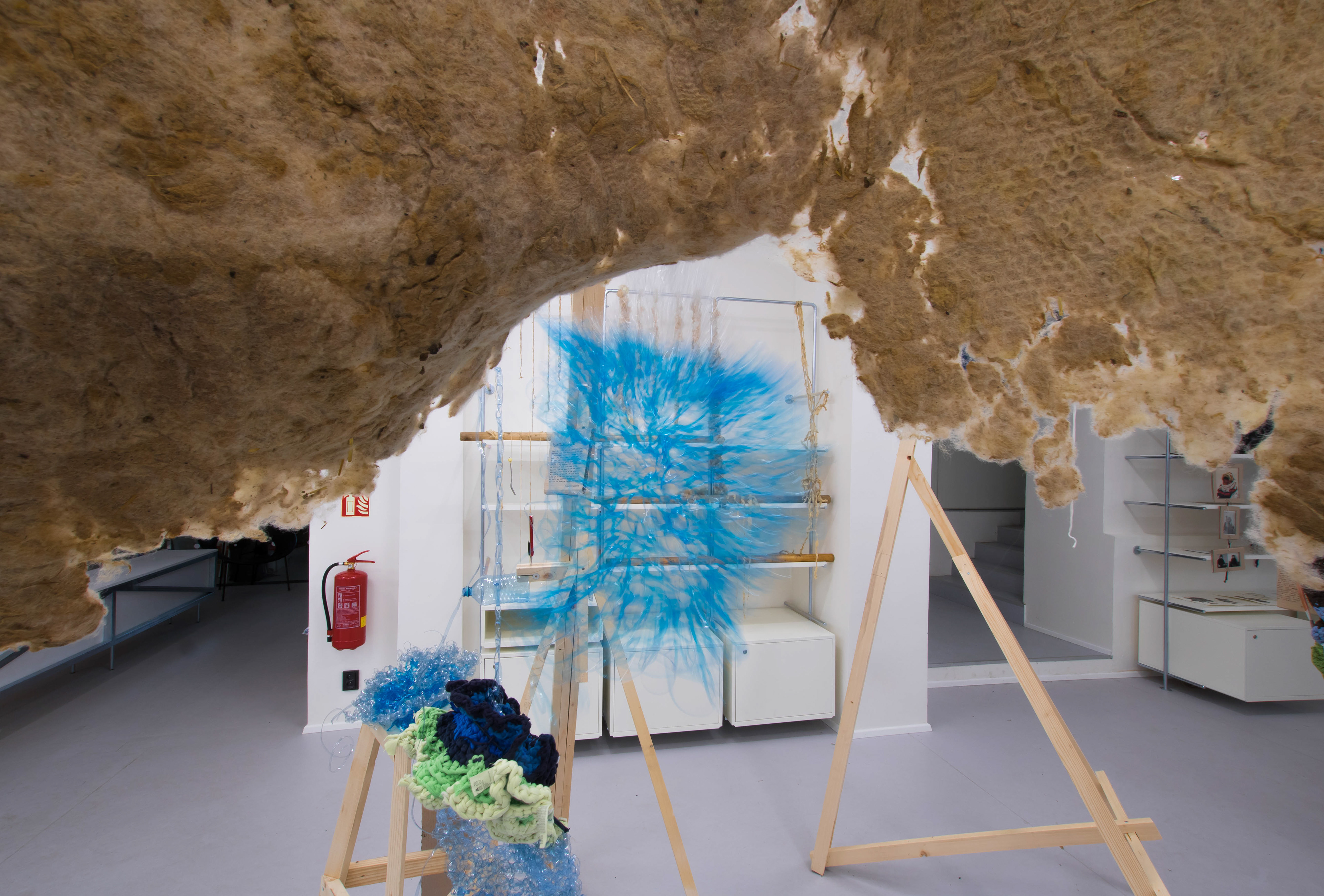
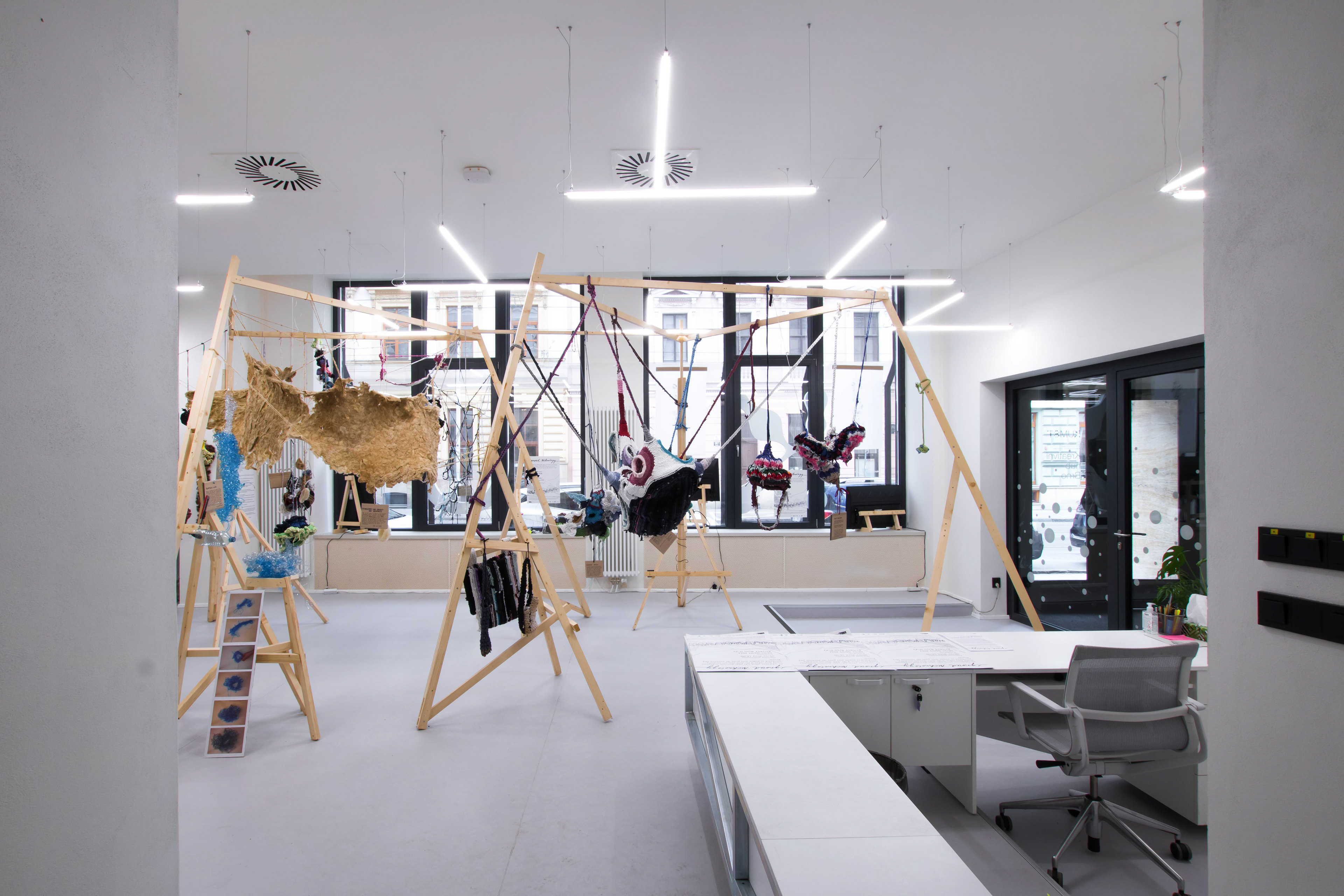
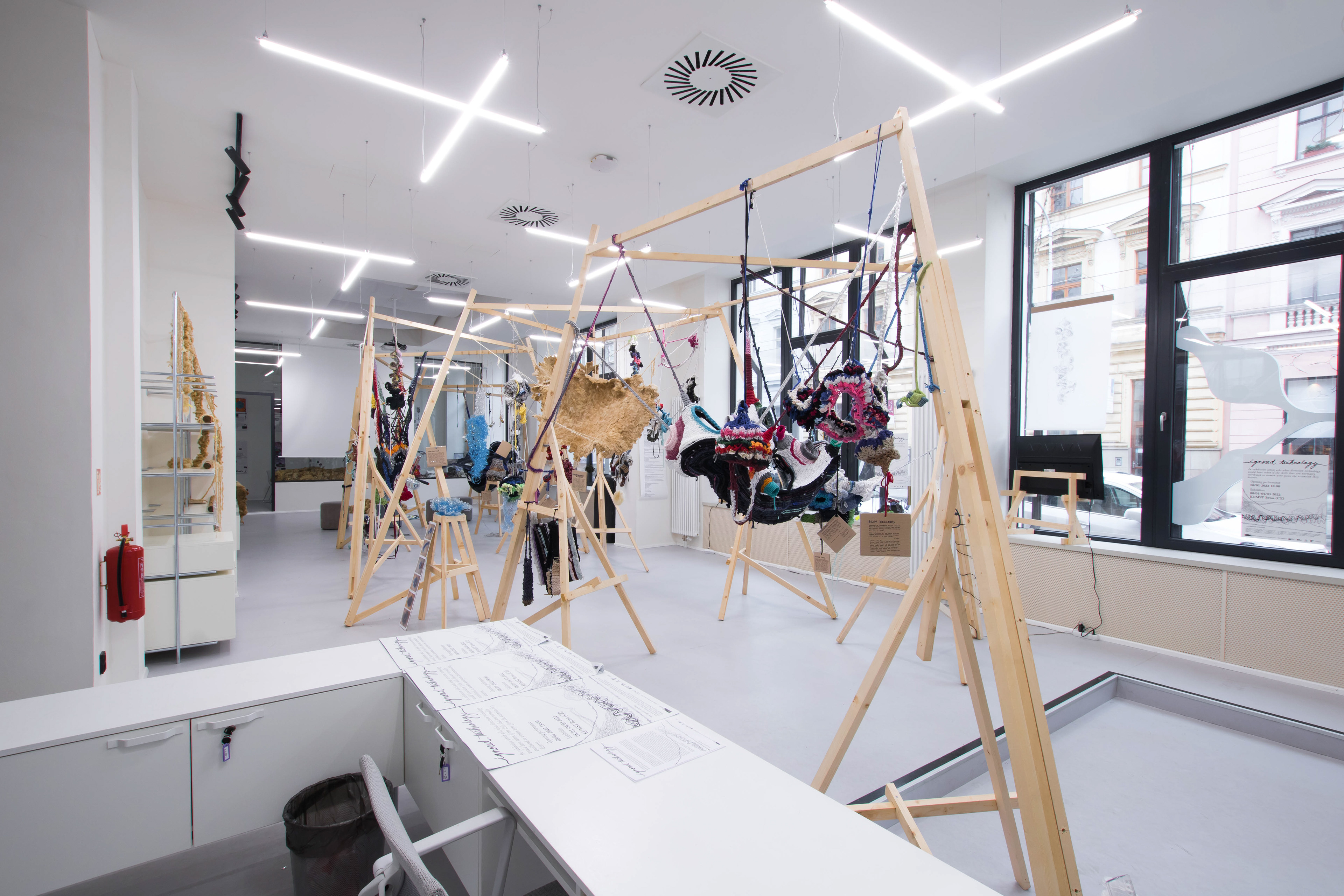

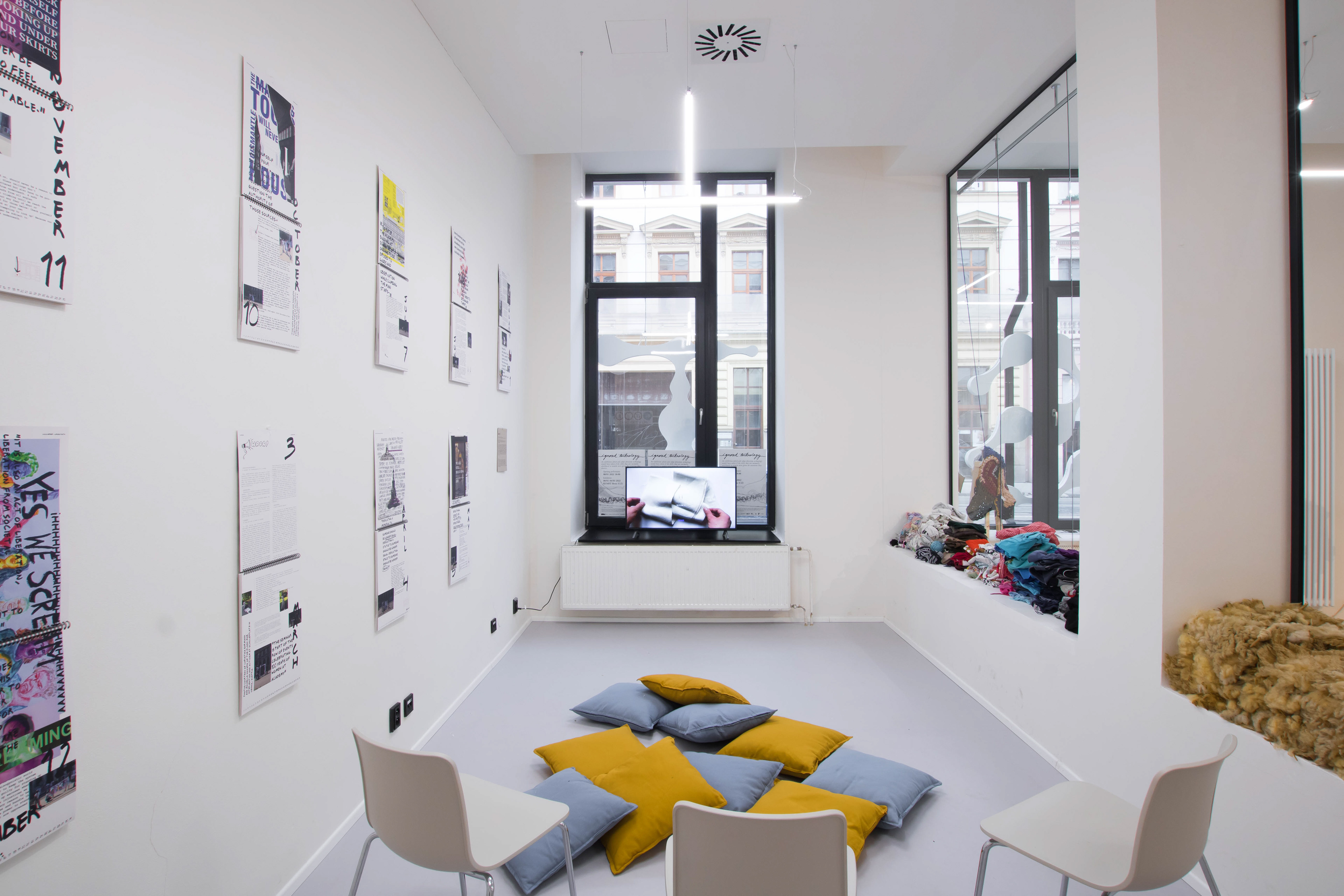




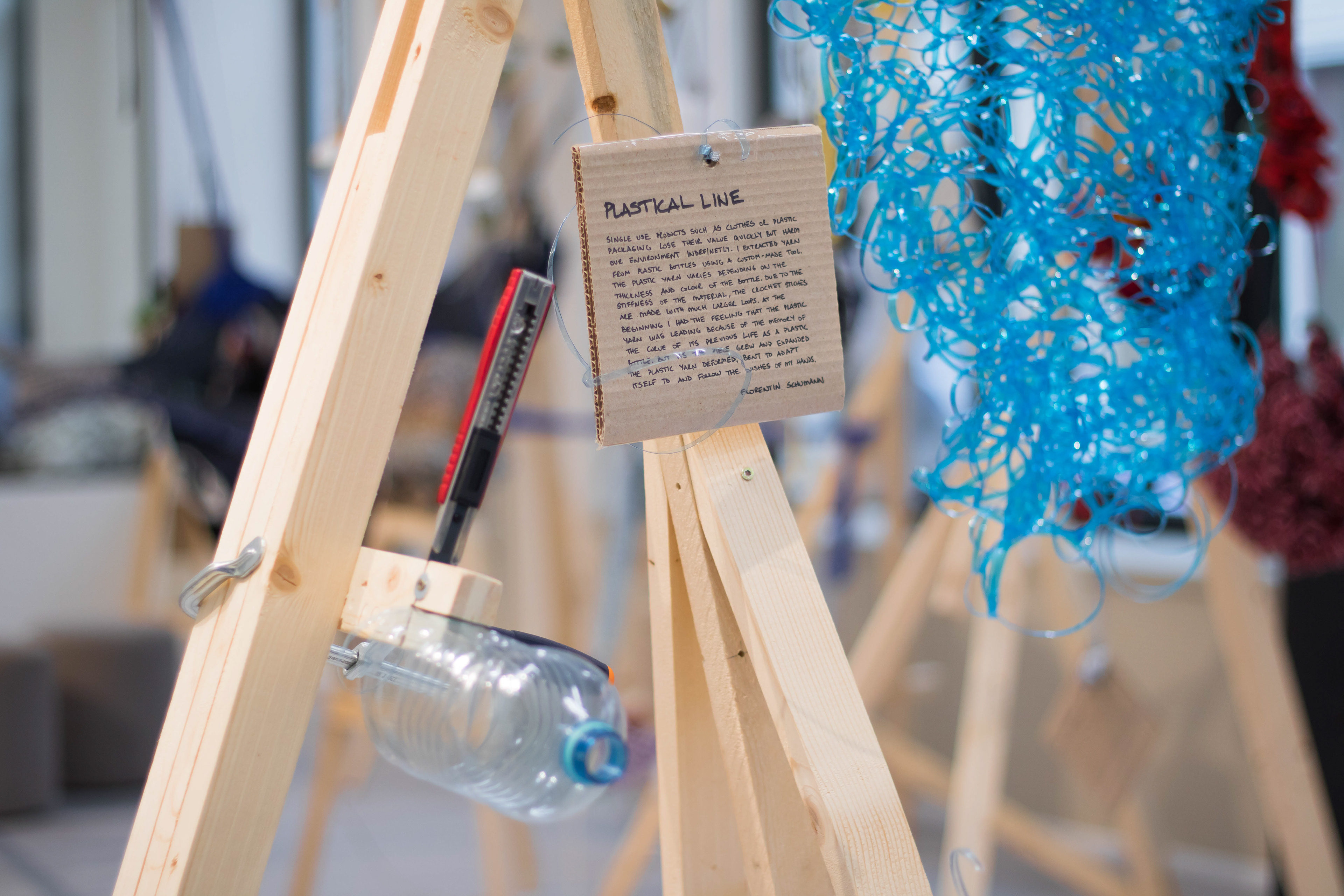













ABENDSTEIN SOFIA
GOOD NEWS
Printing presses run at top speed; paper is printed constantly. Today’s newspaper is already without purpose tomorrow. How to turn old news into something else, to explore paper beyond its limited conventional use? My project injects stiffness into this flexible planar material. Through interlocking loose strands of paper, it transforms into a three-dimensional and stable structure. The discarded newspaper accumulating in my apartment was cut, separated, spun, reconnected, rolled up. Through crocheting techniques a new, self-supporting structure emerged. It plays with height, volume and weight, and lives on its own. A self-supporting spatial structure is formed.<iframe width="560" height="315" src="https://www.youtube.com/embed/DvQjNOMvQ0g" title="YouTube video player" frameborder="0" allow="accelerometer; autoplay; clipboard-write; encrypted-media; gyroscope; picture-in-picture" allowfullscreen></iframe>
ARIN ARDA
2°C
Coral bleaching is a temperature-dependent stress response. At a difference of 2°C, the algae’s ability to photosynthesize and feed its coral host is impaired. Stressed corals eject their algae (zooxanthellae) and subsequently starve leaving dead transparent tissue behind. A multitude of other organisms’ living symbiotically with the corals are also endangered.
This work
i. celebrates the diversity of lines by counting stiches, joining yarns and colours, increasing, decreasing
ii. explores the cryptic mathematics of the natural world via the hyperbolic geometry of corals
iii. proposes that these ignored technologies are the tools we need to construct a symbiotic Anthropocene
GRIFFITH ELLIOTT
TO BE OVERCOME
This project attempts to reveal the reality of consumption, bringing to light its many intertwined relationships. We are actors in this network that deals in cheap merchandise and the values projected upon them. As we consume, a string of actions merges into a finite end all too quickly. As we create the string has yet to become. Here T-shirts, much too abundant and short-lived, compose the starting point for creation. Recycled into yarn and worked with a hook, they are given new life. A threshold on the life-cycle that is there to be overcome!
HANDON LUKE
WATCHING
Watching my hands during the process, how they intervene with the yarn and the emerging space. Watching, how my hands work with the hook, my tool, how the hook and hand are handling the thread, transforming the linear into the spatial. Slowly, the yarn accumulates, changes colour, thickness, and materiality. White, thick threads, from an old tablecloth, followed by rigid, raw ones made from twisted newspaper. Grey elastic yarn alternates with fragile yellow lines. Together they connect and create a multitude of organic bodies. Each evoked by the another. Creating together a vivid and condensed conglomerate of interacting spatial structures.
HAUSCHILDT PAULA
HÄKELMOPPED - a 'crochetage'
HÄKELMOPPED is a multifunctional crocheted hyperbolic structure made using the yarn extracted from 250 discarded and repurposed T-shirts. A possible extension of the lifecycle of old clothing. It has holes of different sizes and ropes which can be used to connect to the surroundings, wrapped hung or tied. But it can also lie directly on the ground. A specific use is not stipulated – you are invited to interact and explore. PLEASE DO TOUCH
Examples for Interaction: toy, place for relaxation, encounter with others, clothing, weight for workouts, rope skipping, ...
HERBER LUCIA
SKETCHING IN 3D
My first contact with crocheting was in elementary school and I was surprised by how quickly my body remembered the gestures I had learned so long ago. The repetitive work had a calming and a meditative effect on me. Then boredom set in, and I invented my own techniques intuitively, prompting the emergence of new spaces that I wouldn't have found using only my head. Designing with the hand and the head while crocheting…A three-dimensional sketch incorporating many differing interlocking planes and yarns. My hand and head adjusting to how they wanted to behave and manifest themselves.
JASAITYTE JUSTA
HANGING CORALS
My expanding knowledge of crochet opened up discoveries of spatial and surface properties I had never expected. These crochet structures have the ability to generate spaces. I explored the potential of the interior and exterior spaces they can create using organic cylindrical shapes as well as the hyperbolic planes. The intuitive process lead to the development of a pipelike crochet structure which ends and descends into the hyperbolic. These cylindrical spaces are not only meant to be looked at but also looked through. The variation of the diameter, length, colour etc... represents the inherent natural complexity of our daily environments.
JUNGBLUT JULIANE
THE NEST
The Nest has developed into a spatial structure. Tight at the bottom, flexibly adjusting to the position of my body, snug and comfortable. More elastic further up, resembling the arms of an octopus, reaching out to grab hold. The difference between home and the outside has been put sharply into focus by the current pandemic. This project seeks to win back the lost time with other people in public spaces. It spreads its tentacles as and challenges us to reengage with each other and the spaces we have in common. It challenges a social code battered by isolation.
LANG MARIE
MESHWORK OF LINES
What does it mean to translate trails into moving lines and fall into the (life) line, challenge its power and strength, interweave the body, build up a continuous line, walking and crocheting. Questioning and exploring the act of wearing, looking closer and deeper into the meshwork. This is an interactive model of thought, where I demonstrate what happens when a network becomes acrobatic and transforms into a meshwork and encases the being who once thought they were directing it. An ever-moving entanglement.
LEE JI YUN
A HOLE STORY
(...) It needed a hole. A large hole through which everything I put in would immediately fall out. Then lines would be free again once the Bilum[1] emancipated from fulfilling the role of a carrier bag. Unravelling the yarn in the middle of the Bilum allows the act of crocheting to commence once more.
[1] BILUM
In Tok Pisin, a language of Papua New Guinea, bilum means womb. But it also refers to a string bag made by hand using yarn from twisted plant fibres and technology known as looping, knotless netting, or crocheting. Traditionally slung behind from the head, it is capable of carrying both light and heavy loads, including small children.
LEE SORYUN
BILUM.BOZAGI
My grandmother folded her bozagi (Korean handkerchief) to carry her belongings. She would put in homemade food and send it to us. Unfolding her bozagi was always something joyful. This bilum[1] is enriched by her bozagi. As this bilum expanded, its shape, and my interactions with it changed. The bilum and the bozagi interacted. The T-Shirt yarn’s elasticity encouraged me to skip and jump, carry and wear. The focus on usefulness has faded away and been replaced by playfulness.
[1] BILUM
In Tok Pisin, a language of Papua New Guinea, bilum means womb. But it also refers to a string bag made by hand using yarn from twisted plant fibres and technology known as looping, knotless netting, or crocheting. Traditionally slung behind from the head, it is capable of carrying both light and heavy loads, including small children.
NASERI MAJED
LIQUID STRUCTURE – AN ALTERNATIVE ASABA[1]
This work is inspired by the culture of Iraqi Marsh Arabs, it responds to its environment going beyond functionality. They occupy a 6,000 square-mile wetland created by the Tigris and Euphrates rivers, the cradle of human civilization. Marsh Arabs traditionally work and live together along lines defined not by gender but the physical conditions of the person. Men and women weave and hunt. Similarly their clothes are defined solely by comfort and ease of movement. Their most stable structure, is the one most capable of transforming, extending, moving and flowing. Modernity cannot impose its laws. Here the structures are liquid.
[1] ASABA: A black 2-4 meters long headgear for marsh women in Iraq
SAIED LAURIN
AWARE OF WHAT YOU WEAR.
In this crochet piece, I focus on the relation and interaction of four fibres: wool, polyester, jute and linen. Yarns I chose because of their presence in my wardrobe and daily life and created from their discarded versions. They are varied in microscopic and macroscopic texture, roughness, strength and flexibility, but also in their treatment. Their interconnection impacts the act of crocheting and the resulting spaces. Pulling the threads with their different characteristics over hands and fingers, finding comfortable compromises between the tension in the yarn, the hand and the needle, lead to differences in the act and the piece.
SCHUMANN FLORENTIN
PLASTICAL LINE
single use products such as clothes or plastic packaging lose their value quickly but harm our environment indefinitely. I extracted yarn from plastic bottles using a custom-made tool. The plastic yarn varies depending on the thickness and colour of the bottle. Due to the stiffness of the material, the crochet stitches are made with much larger loops. At the beginning I had the feeling that the plastic yarn was leading because of the memory of the curve of its previous life as a plastic bottle. But as the piece grew and expanded the plastic yarn deformed and bent to adapt itself to and follow the wishes of my hands.
TISCHENDORF MORITZ
A COLLABORATION OF CONSTRUCTIONS
I started my 3-dimensional crocheting with a circle, followed the rhythm of single and double stitch combinations, and was lead to a hyperbolic plane. As I continued, I started to connect separate “finished”, pieces, and realised that more possibilities were opening up as I worked. My crochet work produced the ideas with me, allowing us to break out of the repetitive pattern and go further into unexpected territories. The current state of one continuous piece, is also an assembly of disparate elements, a collaboration of constructions with their own unique characteristics.
WIZANY XAVER
NEVER-ENDING PER-FORM-ANCE
I painted hands. I painted a craft. The crafting of a piece does not last long, what remains are the objects we produce. But why look at craft in this hylomorphic way? What is with the activity behind the objects we create? Paul Klee wrote that ‘Form is the end, death. Form-giving is movement, -action. Form-giving is life. [1]. I have attempted to observe and manifest the memory and creativity of our dextrous hands by recording the never-ending per-Form-ance of two shape giving activities, crocheting and drawing, allowing them to interact and flow.
[1] From the notebooks of Paul Klee published in 1973, Lund Humphries, London, Volume 2, page 269.